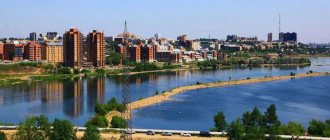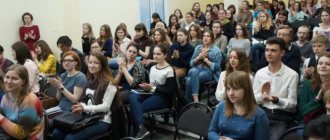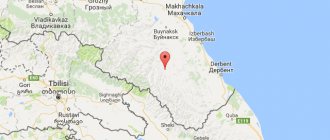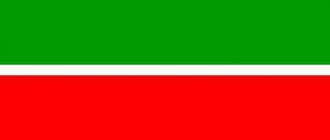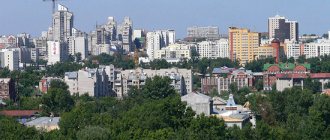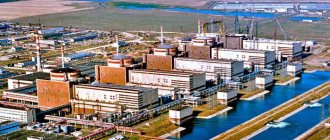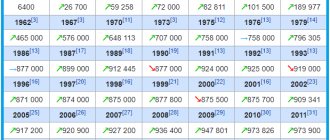Irkutsk region
- Alzamay - 6135.
- Angarsk - 226777.
- Baikalsk - 12900.
- Biryusinsk - 8484.
- Bodaibo - 13420.
- Bratsk - 234145.
- Vikhorevka - 21455.
- Zheleznogorsk-Ilimsky - 23980.
- Winter - 31282.
- Irkutsk - 623420. An ancient city with many cultural and historical attractions.
- Kirensk - 11435.
- Nizhneudinsk - 43050.
- Sayansk - 38955.
- Svirsk - 13126.
- Slyudyanka - 18300.
- Taishet - 33587.
- Tulun - 41988.
- Usolye-Sibirskoye - 78563.
- Ust-Ilimsk - 82828.
- Ust-Kut - 42499.
- Cheremkhovo - 51337.
- Shelekhov - 47377.
Murmansk
Thanks to the warm Gulf Stream, the warmest of the cities in the Far North located above the Arctic Circle is Murmansk. The Kola Bay, along which Murmansk is located, never freezes (city residents recall only a few cases of the bay freezing). The city is quite favorable for life, so more than 300 thousand people live here.
Murmansk was founded in 1916 as a port city on the Barents Sea. Currently, Murmansk has a commercial and military port.
As in other cities of the Far North region, the climate of Murmansk is quite difficult for people. A short, inhospitable summer, bright but quickly passing autumn and spring, a long frosty winter. The polar night, which lasts for 42 days, is especially depressing for residents. There is very little vegetation in Murmansk.
Kemerovo region
- Anzhero-Sudzhensk - 72825.
- Belovo - 73401.
- Berezovsky - 47140.
- Guryevsk - 23360.
- Kaltan - 21185.
- Kemerovo - 553075. In recent years, there has been a deterioration in the environmental situation in the city due to the work of industrial enterprises.
- Kisilevsk.
- Leninsk-Kuznetsky - 97666.
- Mariinsk - 39330.
- Mezhdurechensk - 98730.
- Toes - 41940.
- Novokuznetsk - 551255. A beautiful modern city. One of the oldest in Siberia.
- Osinniki - 43445.
- Polysayevo - 26737.
- Prokopyevsk - 198430.
- Taiga - 24530.
- Tashtagol - 23080.
- Fireboxes - 28145.
- Yurga - 81400.
Norilsk
Norilsk, a large industrial city in the Far North, is located in the Krasnoyarsk Territory. It begins its history in 1921, when giant deposits of ore and metals were discovered on its territory by the famous Russian explorer Urvantsev. Therefore, in 1935, construction began on a mining and metallurgical plant, which later grew into the world-famous industrial giant Norilsk Nickel. The plant and the city were built by Gulag prisoners.
The state of the environment in Norilsk is close to catastrophic. It is one of the ten dirtiest cities in the world.
The climate of Norilsk is very harsh. During the short summer, the air temperature can exceed 30 degrees Celsius, and during the long winter the temperature drops below −50 °C. The picture of the Norilsk winter is aggravated by the most severe frosty winds (more than 40 meters per second).
The population of Norilsk is 176.5 thousand people, and this figure is constantly decreasing due to the relocation of residents of the cities of the Far North to warmer and more favorable regions of Russia. But it is temporarily replenished by people who come to work.
There are enough places in the city that are considered the most northern. These are the Norilsk Industrial Institute, the Orthodox Temple of All Who Sorrow Joy, the Nurd-Kamal Mosque, the Norilsk Polar Drama Theater named after Vladimir Mayakovsky.
Krasnoyarsk region
- Artyomovsk - 1777.
- Achinsk - 105366.
- Bogotol - 20477.
- Borodino - 16220.
- Divnogorsk - 29050.
- Dudinka - 21974.
- Yeniseisk - 18155.
- Zheleznogorsk - 84542.
- Zaozerny - 10270.
- Zelenogorsk - 62670.
- Igarka - 4979.
- Ilansky - 15134.
- Kansk - 91 019.
- Kodinsk - 16222.
- Krasnoyarsk - 1066944. A city of over a million people, the heyday of which began during the “gold rush” in the 2nd half of the 19th century.
- Lesosibirsk - 59846.
- Minusinsk - 68310.
- Nazarovo - 60652.
- Norilsk - 177430.
- Sosnovoborsk - 38416.
- Uyar - 12210.
- Uzhur - 15567.
- Sharypovo - 37258.
List of cities in the Far North of Russia
The following Russian cities belong to the Far North:
- the city of Severodvinsk in the Arkhangelsk region;
- the city of Kostomuksha in the Republic of Karelia;
- the cities of Vorkuta, Inta and Pechora in the Komi Republic;
- the cities of Igarka and Norilsk in the Krasnoyarsk Territory;
- the city of Okha in the Sakhalin region.
There are also a number of cities equated to regions of the Far North. The largest of them are Arkhangelsk, Petrozavodsk, Syktyvkar, Komsomolsk-on-Amur.
Vorkuta
In the north of the Komi Republic, beyond the Arctic Circle in the land Arctic zone, the easternmost European city is located - the city of Vorkuta. In Stalin's times, on the territory of Vorkuta there was Vorkutlag, in which prisoners were engaged in coal mining. In 1943, Vorkuta was given city status.
A considerable part of the Vorkuta buildings were planned by Leningrad architects. In Soviet times, Vorkuta was a prosperous city, but with the collapse of the Union, most of the mines were closed and people were forced to leave. Now the situation in the city has stabilized, but the period of prosperity is left behind. Visitors get the impression that time has stood still in Vorkuta since Soviet times. Currently, only a little over 58 thousand people live in the city.
On the eastern side the city is closed by the Ural Mountains. And in the northwest of the city there is tundra. Therefore, in addition to the Polar Night and severe frosts, city residents experience terrible winds (more than 30 meters per second). It is not safe to go out into the tundra in such a snowstorm.
The population of Vorkuta is multinational, which is explained by the origin of the city.
The ecology of Vorkuta is not in the best condition. There is a lack of oxygen in the air due to the lack of trees, but there is an abundance of black coal dust.
Grouping cities by population
According to the set of rules “Urban planning. Planning and development of urban and rural settlements" (SP 42.13330.2011) from the Ministry of Regional Development, the country's cities are classified as follows:[6]
- The largest - with a population of over 1 million people.
- Large - from 250 thousand people. up to 1 million people (including subcategories from 250 to 500 thousand and from 500 thousand to 1 million people)
- Large - from 100 to 250 thousand people.
- Medium - from 50 to 100 thousand people.
- Small [7] - up to 50 thousand people. (including subcategories up to 10 thousand, from 10 to 20 thousand and from 20 to 50 thousand people)
Estimated as of January 1, 2016[8]
| Federal District | Largest (over 1 million) | Large (500 thousand - 1 million) | Large (250 thousand - 500 thousand) | Large (100 thousand - 250 thousand) | Medium (50 thousand - 100 thousand) | Small (up to 50 thousand) | Total |
| Far Eastern | 0 | 2 | 2 | 6 | 6 | 51 | 67 |
| Crimean1 | 0 | 0 | 2 | 2 | 2 | 11 | 17 |
| Privolzhsky | 5 | 7 | 5 | 15 | 35 | 132 | 199 |
| North-West2 | 1 | 0 | 6 | 4 | 14 | 121 | 146 |
| North Caucasian | 0 | 1 | 3 | 10 | 10 | 32 | 56 |
| Siberian | 3 | 5 | 2 | 11 | 20 | 89 | 130 |
| Ural | 2 | 1 | 5 | 8 | 17 | 82 | 115 |
| Central3 | 2 | 3 | 14 | 25 | 35 | 224 | 303 |
| Southern | 2 | 2 | 4 | 9 | 16 | 46 | 79 |
| Total1, 2, 3 | 15 | 21 | 43 | 90 | 155 | 788 | 1112 |
| Population, people | 32 997 392 | 12 930 987 | 15 100 216 | 13 751 713 | 10 810 007 | 16 060 203 | 101 650 518 |
| Population, % | 32,46 % | 12,72 % | 14,86 % | 13,53 % | 10,63 % | 15,80 % | 100,00 % |
1 In July 2016, the Crimean Federal District was abolished and included in the Southern Federal District. Not including 2 cities within Sevastopol (Inkerman and Balaklava), which have the status of or are part of the intra-city municipalities of Sevastopol. 2 Not including the cities of Zelenogorsk, Kolpino, Krasnoe Selo, Kronstadt, Lomonosov, Pavlovsk, Petergof, Pushkin, Sestroretsk as part of the districts of St. Petersburg as having the status of intracity municipalities of St. Petersburg 3 Not including 3 cities within the new borders of Moscow (Moskovsky, Shcherbinka and Troitsk), having the status of settlements as intra-city municipalities); not including the city of Zelenograd, previously considered as a separate city in Moscow, which has the status of one of the administrative districts of Moscow.[8]
According to the 2010 census[1]
| Federal District | Largest (over 1 million) | Large (500 thousand - 1 million) | Large (250 thousand - 500 thousand) | Large (100 thousand - 250 thousand) | Medium (50 thousand - 100 thousand) | Small (up to 50 thousand) | Total |
| Far Eastern | 0 | 2 | 2 | 6 | 6 | 50 | 66 |
| Privolzhsky | 5 | 7 | 4 | 17 | 35 | 130 | 198 |
| Northwestern | 1 | 0 | 6 | 4 | 13 | 122 | 146 |
| North Caucasian | 0 | 1 | 3 | 9 | 8 | 35 | 56 |
| Siberian | 2 | 6 | 2 | 12 | 19 | 89 | 130 |
| Ural | 2 | 1 | 5 | 8 | 17 | 82 | 115 |
| Central | 2 | 3 | 11 | 25 | 40 | 228 | 310 |
| Southern | 2 | 2 | 3 | 10 | 17 | 45 | 79 |
| Total | 14 | 25 | 36 | 91 | 155 | 781 | 1100 |
| Population, people | 28 222 475 | 15 754 662 | 12 146 124 | 14 105 196 | 10 854 230 | 16 444 121 | 97 526 808 |
| Population, % | 28,9 | 16,2 | 12,5 | 14,5 | 11,1 | 16,9 | 100,0 |
By January 1, 2013, the number of cities in the country had decreased to 1097 due to Moscow’s absorption of the territories of three cities (Moskovsky, Shcherbinka and Troitsk)[9].
Estimated as of January 1, 2013[9]
| Federal District | Largest (over 1 million) | Large (500 thousand - 1 million) | Large (250 thousand - 500 thousand) | Large (100 thousand - 250 thousand) | Medium (50 thousand - 100 thousand) | Small (up to 50 thousand) | Total |
| Far Eastern | 0 | 2 | 2 | 6 | 6 | 50 | 66 |
| Privolzhsky | 5 | 7 | 5 | 16 | 35 | 130 | 198 |
| Northwestern | 1 | 0 | 6 | 4 | 12 | 123 | 146 |
| North Caucasian | 0 | 1 | 3 | 10 | 8 | 34 | 56 |
| Siberian | 3 | 5 | 2 | 11 | 20 | 89 | 130 |
| Ural | 2 | 1 | 5 | 8 | 16 | 83 | 115 |
| Central2 | 2 | 3 | 12 | 27 | 37 | 226 | 307 |
| Southern | 2 | 2 | 4 | 9 | 16 | 46 | 79 |
| Total2 | 15 | 21 | 39 | 91 | 150 | 781 | 1097 |
| Population, people | 32 086 133 | 12 627 203 | 13 347 065 | 13 937 429 | 10 508 649 | 16 343 885 | 98 793 161 |
| Population, % | 32,5 | 12,8 | 13,5 | 14,1 | 10,6 | 16,5 | 100,0 |
2Not including 3 cities within the new boundaries of the city of Moscow: Moskovsky (20,386 people), Shcherbinka (35,328 people) and Troitsk (43,980 people as of January 1, 2013)[9].
Estimated as of January 1, 2014[10]
| Federal District | Largest (over 1 million) | Large (500 thousand - 1 million) | Large (250 thousand - 500 thousand) | Large (100 thousand - 250 thousand) | Medium (50 thousand - 100 thousand) | Small (up to 50 thousand) | Total |
| Far Eastern | 0 | 2 | 2 | 6 | 6 | 50 | 66 |
| Privolzhsky | 5 | 7 | 5 | 15 | 36 | 130 | 198 |
| Northwestern | 1 | 0 | 6 | 4 | 13 | 122 | 146 |
| North Caucasian | 0 | 1 | 3 | 10 | 10 | 32 | 56 |
| Siberian | 3 | 5 | 2 | 11 | 20 | 89 | 130 |
| Ural | 2 | 1 | 5 | 8 | 16 | 83 | 115 |
| Central3 | 2 | 3 | 12 | 27 | 36 | 227 | 307 |
| Southern | 2 | 2 | 4 | 9 | 16 | 46 | 79 |
| Total3 | 15 | 21 | 39 | 90 | 153 | 779 | 1097 |
| Population, people | 32 079 163 | 12 754 954 | 13 449 683 | 13 895 593 | 10 703 298 | 16 141 189 | 99 023 880 |
| Population, % | 32,40 % | 12,88 % | 13,58 % | 14,03 % | 10,81 % | 16,30 % | 100,00 % |
3Not including 3 cities within the new boundaries of the city of Moscow: Moskovsky (24,210 people), Shcherbinka (38,905 people) and Troitsk (47,291 people as of January 1, 2014)[10].
By January 1, 2015, the number of cities increased to 1114 due to the cities of Crimea annexed to Russia in the spring of 2014.
Estimated as of January 1, 2015[11]
| Federal District | Largest (over 1 million) | Large (500 thousand - 1 million) | Large (250 thousand - 500 thousand) | Large (100 thousand - 250 thousand) | Medium (50 thousand - 100 thousand) | Small (up to 50 thousand) | Total |
| Far Eastern | 0 | 2 | 2 | 6 | 6 | 50 | 66 |
| Crimean | 0 | 0 | 2 | 2 | 2 | 11 | 17 |
| Privolzhsky | 5 | 7 | 5 | 15 | 35 | 132 | 199 |
| Northwestern | 1 | 0 | 6 | 4 | 13 | 122 | 146 |
| North Caucasian | 0 | 1 | 3 | 10 | 10 | 32 | 56 |
| Siberian | 3 | 5 | 2 | 11 | 20 | 89 | 130 |
| Ural | 2 | 1 | 5 | 8 | 16 | 83 | 115 |
| Central1 | 2 | 3 | 13 | 26 | 37 | 225 | 306 |
| Southern | 2 | 2 | 4 | 9 | 16 | 46 | 79 |
| Total1 | 15 | 21 | 42 | 91 | 155 | 790 | 1114 |
| Population, people | 32 386 896 | 12 852 979 | 14 543 345 | 13 986 954 | 10 861 119 | 16 210 922 | 100 842 215 |
| Population, % | 32,12 % | 12,75 % | 14,42 % | 13,87 % | 10,77 % | 16,08 % | 100,00 % |
1Not including 3 cities within the new boundaries of the city of Moscow (Moskovsky, Shcherbinka and Troitsk) and not including the abolished city of Yubileiny within the new borders of the city of Korolev[11].
Nicknames of Russian cities, towns and cities: the most complete list
But savvy people carefully copied and pasted the source and posted it on the Internet. We, on the advice of the same crafty book, found this option on the Blabforum.ru forum. Look for your native village, metropolis and village and check if everything is so! If there are any additions or notes, please write to us.
PS After the publication of this publication, the editors of our site began to receive alarming messages from grateful readers with previously unknown city nicknames, and the list is expanding, growing, and becoming prettier. Hooray!
Alexandrov - Alex, Oprichnaya capital, Bloodthirsty city (as Ivan the Terrible called Alexandrovskaya Sloboda), Capital of the 101st kilometer, Lyaksandrov (hostile).
Almetyevsk - Almetka (unofficial abbreviation of the full name), Oil capital of Tatarstan.
Apatity - Hepatity, Apache.
Arkhangelsk - Gateway to the Arctic, Arkhara (an unofficial abbreviation of its full name), City of boards, cod and melancholy.
Barnaul - Barneapol, Barneo, Barnadyr (dismissively).
Belgorod - White City (chalk mountains), City of the first salute (The first Victory salute sounded on August 5, 1943 in Moscow in connection with the liberation of Orel and Belgorod - 12 salvoes from 124 guns).
Berezniki - Republic of Chemistry, Bera and Beriki (unofficial abbreviations from the full name).
Blagoveshchensk - Blaga (abbreviated).
Big Stone - Stone, Big Stone.
Bor - Konoplyansk, Narkomanstadt (both due to the large number of drug addicts and drug dealers).
Bryansk - GeBryansk, Bryansk (dismissively, because of the proximity to Belarus and Ukraine, many residents “hack”).
Velikiye Luki - Luki.
Veliky Novgorod - Novgorod, Mister Veliky Novgorod, Nova Gorod (historical).
Vesyegonsk - Saigon.
Vladivostok - City of Nashensky (according to the famous quote from Lenin - “Vladivostok is far away, but it’s a city of Nashensky!”), Vladik, Vlad (short for the full name), City V (local, due to the absence of other significant cities in the region starting with the letter V ), Haishenwei (Chinese: 海参崴) is an unofficial Chinese name.
Vladikavkaz - Ordzho (disparagingly from the old name - Ordzhonikidze), Vladik (short for the full name).
Vologda - Nason-city (historical nickname), Failed capital (there is a theory that Ivan IV the Terrible wanted to turn Vologda into the capital), Cultural capital of the Russian North (as a result of the action of the same name to beautify the city in honor of its 860th anniversary).
Voronezh - The capital of the Black Earth Region, the city of Voron-i-Yozh, VRN, VRN (abbreviation).
Vyshny Volochyok - Volochyok (an unofficial abbreviation of the full name), Svolochyok, Tver Venice.
Glazov - Glasgow, Glazkar (from the Udmurt name “Eye of Kar”).
Dalnegorsk, Dalnerechensk - Dalnik, Dalik (abbreviation).
Dzerzhinsk - Dust (from a large number of chemical plants and poor ecology), Rastyapino (the name of the city until 1924).
Dikson is the capital of the Arctic.
Dimitrovgrad - Melekess (historical name), Dim-grad, D-grad, 2D, DD (abbreviations).
Dolgoprudny - Dolgopa (abbreviation).
Ekaterinburg - E-burg, Yo-burg, Joburg, Ek, Ekb, Ekat, Katyukha, Kater (unofficial abbreviations from the full name), Katkingrad, Sverdlovsk (since it is the capital of the Sverdlovsk region), Superzhlobsk (from Sverdlovsk), Capital of the Urals, Yeltsinburg (as the birthplace of B.N. Yeltsin, the first president of the Russian Federation), Chaiftown (as the birthplace of the rock group Chaif), the capital of Russian rock and roll (the groups Agatha Christie and Nautilus Pompilius came from the former Sverdlovsk ", "Chaif", "Nastya", "Semantic hallucinations", "Chicherina", etc.), Capital of Eurasia, Window to Asia.
Efremov - Efrik (unofficial abbreviation of the full name).
Zelenograd - Zelek, Zelik, Zelen, Zelenka (unofficial abbreviations from the full name), Greencity and Greentown (Russian transcriptions of the English Greencity and Greentown), Russian Silicon Valley (as a Russian center of electronics).
Zlatoust - Zlat, Zlatik (abbreviations).
Ivanovo - City of Brides, Calico Region, Textile Capital of Russia, Homeland of the First Council (People's Deputies), Russian Manchester (before the 1917 Revolution), Red Manchester (after the Revolution), Ivanovka (disdainful), Yerevanovo (joking), Nirvano-Voznesensk ( a playful alteration of the old name Ivanovo-Voznesensk), Ubahobo (transliteration of the spelling of the name in Latin letters - UBAHOBO)
Notes[edit | edit wiki text]
↑ Show compactly
- ↑ Go to: 1 2 State Statistics Committee of the Russian Federation. Final results of VPN 2010: 6. Grouping of urban settlements by population size by constituent entities of the Russian Federation
- Table 2. Population of districts and urban settlements of the constituent entities of the Russian Federation // Preliminary results of the 2010 All-Russian Population Census: Stat. Sat./Rosstat.. - Moscow: IRC "Statistics of Russia", 2011. - P. 32 - 86.
- This number does not include 9 cities administratively included in the districts of St. Petersburg: Zelenogorsk, Kolpino, Krasnoe Selo, Kronstadt, Lomonosov, Pavlovsk, Petergof, Pushkin, Sestroretsk
- Much of the Crimean Peninsula is the subject of a territorial dispute between Russia, which controls the disputed territory, and Ukraine. According to the federal structure of Russia, the constituent entities of the Russian Federation, the Republic of Crimea, and the federal city of Sevastopol are located on the disputed territory of Crimea. According to the administrative division of Ukraine, the disputed territory of Crimea includes the Ukrainian regions of the Autonomous Republic of Crimea and the city with a special status of Sevastopol.
- Law of the Republic of Ingushetia “On the transformation of the urban-type settlement Sunzha, Sunzhensky district of the Republic of Ingushetia” dated November 25, 2016 N 43-RZ
- ↑ Go to: 1 2 3 4 MINISTRY OF REGIONAL DEVELOPMENT OF THE RF. Set of rules SP 42.13330.2011 Urban planning. Planning and development of urban and rural settlements Updated edition. SNiP 2.07.01-89. Official publication - Moscow 2011
- In addition to cities, the category “small” (according to the set of rules SP 42.13330.2011 from the Ministry of Regional Development) includes all urban-type settlements. Here (in the tables of this article) urban-type settlements are not taken into account
- ↑ Go to: 1 2 3 Rosstat. Federal State Statistics Service. Population of the Russian Federation as of January 1, 2016. 26. Grouping the number of cities by the population living in them, as of January 1, 2016; 27. Grouping of the population living in cities as of January 1, 2016
- ↑ Go to: 1 2 3 4 Rosstat. Federal State Statistics Service. Population of the Russian Federation as of January 1, 2013. 24. Grouping the number of cities by the population living in them, as of January 1, 2013; 25. Grouping of the population living in cities as of January 1, 2013
- ↑ Go to: 1 2 3 4 Rosstat. Federal State Statistics Service. Population of the Russian Federation as of January 1, 2014. 24. Grouping the number of cities by the population living in them, as of January 1, 2014; 25. Grouping of the population living in cities as of January 1, 2014
- ↑ Go to: 1 2 3 4 5 Rosstat. Federal State Statistics Service. Population of the Russian Federation as of January 1, 2015. 24. Grouping the number of cities by the population living in them, as of January 1, 2015; 25. Grouping of the population living in cities as of January 1, 2015
- ↑ Go to: 1 2 3 4 5 6 Population of the Russian Federation by municipalities as of January 1, 2016
- ↑ Go to: 1 2 3 4 5 6 Population of the Russian Federation by municipalities as of January 1, 2015. Retrieved August 6, 2015. Archived August 6, 2015.
- ↑ Go to: 1 2 3 4 5 6 7 8 Table 33. Population of the Russian Federation by municipalities as of January 1, 2014. Retrieved August 2, 2014. Archived August 2, 2014.
- ↑ Go to: 1 2 3 4 5 6 7 8 Population of the Russian Federation by municipalities as of January 1, 2013. - M.: Federal State Statistics Service Rosstat, 2013. - 528 p. (Table 33. Population of urban districts, municipal districts, urban and rural settlements, urban settlements, rural settlements). Retrieved November 16, 2013. Archived November 16, 2013.
- ↑ Go to: 1 2 3 4 5 6 Population of the Russian Federation by municipalities. Table 35. Estimated resident population as of January 1, 2012. Retrieved May 31, 2014. Archived May 31, 2014.
- ↑ Go to: 1 2 According to the formulations of the Ministry of Regional Development of the Russian Federation, large cities include cities with a population ranging from 250 thousand to 500 thousand, and from 500 thousand to 1 million people.
- ↑ Go to: 1 2 Population of Russia, federal districts, constituent entities of the Russian Federation, districts, urban settlements, rural settlements - district centers and rural settlements with a population of 3 thousand people or more.
- The list of large cities does not take into account the city of Kolpino (population according to the 2010 census 139.0 thousand people), administratively included in the Kolpinsky district of St. Petersburg and statistically included in St. Petersburg as a municipal entity, as well as the former city of Zelenograd (population according to 2010 census 223.9 thousand inhabitants), which is the Zelenograd administrative district within Moscow proper.
- The list of large cities does not take into account the city of Kolpino (population as of January 1, 2013 is 143.1 thousand people), administratively included in the Kolpinsky district of St. Petersburg, as well as the former city of Zelenograd (population as of January 1, 2013 226.5 thousand). residents), which is the Zelenograd administrative district within Moscow proper.
- The list of large cities does not include the cities of Kolpino (population as of January 1, 2014 is 144,412 inhabitants) and Pushkin (100,753 inhabitants), administratively included in the Kolpinsky and Pushkinsky districts of St. Petersburg, respectively, and statistically included in the city of St. Petersburg itself as municipal entities , as well as the former city of Zelenograd (population as of January 1, 2014, 229,926 inhabitants), which is the Zelenograd administrative district within Moscow proper.
- The list of large cities does not include the cities of Kolpino (population as of January 1, 2015 is 144,801 residents) and Pushkin (101,101 residents), administratively included in the Kolpinsky and Pushkinsky districts of St. Petersburg, respectively, and statistically included in the city of St. Petersburg itself as municipal entities , as well as the former city of Zelenograd (population as of January 1, 2015, 232,489 inhabitants), which is the Zelenograd administrative district within Moscow proper.
- ↑ Go to: 1 2 Rosstat. Federal State Statistics Service. Population of the Russian Federation as of January 1, 2015. 33. Resident population of the constituent entities of the Russian Federation by municipalities as of January 1, 2015.
- The list of large cities does not include the cities of Kolpino (population as of January 1, 2016 is 144,288 inhabitants) and Pushkin (102,729 inhabitants), administratively included in the Kolpinsky and Pushkinsky districts of St. Petersburg, respectively, and statistically included in the city of St. Petersburg itself as municipal entities , as well as the former city of Zelenograd (population as of January 1, 2016, 237,897 inhabitants), which is the Zelenograd administrative district within Moscow proper.
- ↑ Go to: 1 2 Rosstat. Federal State Statistics Service. Population of the Russian Federation as of January 1, 2016. 33. Resident population of the constituent entities of the Russian Federation by municipalities as of January 1, 2016.
- The list of medium-sized cities does not take into account the cities of Peterhof (the population as of January 1, 2013 was 74.3 thousand people) and Pushkin (97.3 thousand people), administratively included in the Petrodvortsovy and Pushkinsky districts of St. Petersburg, respectively, and statistically included in the composition of the the city of St. Petersburg as municipalities.
- The list of medium-sized cities does not include the cities of Peterhof (population as of January 1, 2014 was 75,267 people) and Krasnoe Selo (50,251 people), administratively included in the Petrodvortsovy and Krasnoselsky districts of St. Petersburg, respectively, and statistically included in the city of St. Petersburg itself as municipal entities . Another municipal entity - the city of Pushkin in the Pushkinsky district - exceeded 100 thousand people. by January 1, 2014.
- The list of medium-sized cities does not include the cities of Peterhof (the population as of January 1, 2015 was 76,827 people) and Krasnoe Selo (52,573 people), administratively included in the Petrodvortsovy and Krasnoselsky districts of St. Petersburg, respectively, and statistically included in the city of St. Petersburg itself as municipal entities .
- The list of medium-sized cities does not include the cities of Peterhof (the population as of January 1, 2016 was 78,457 people) and Krasnoye Selo (54,422 people), administratively included in the Petrodvortsovy and Krasnoselsky districts of St. Petersburg, respectively, and statistically included in the city of St. Petersburg itself as municipal entities ; as well as the former city of Troitsk (the population as of January 1, 2016 reached 53,519 people), administratively included in the Troitsky administrative district as a settlement.
- The list of small towns does not include the cities (1) Zelenogorsk (population as of January 1, 2016 was 14,968 people), Kronstadt (44,374 people), Lomonosov (43,244 people), Pavlovsk (16,525 people), Sestroretsk (40,090 people), administratively included in districts of St. Petersburg and statistically included in the city of St. Petersburg itself as municipal entities; (2) also the cities of Shcherbinka (the population as of January 1, 2016 reached 42,642 people) and Moskovsky (39,784 people), administratively included in the Novomoskovsky administrative district and statistically included in the city of Moscow itself as municipal entities with the status of settlements; (3) also the cities of Inkerman (the population as of January 1, 2016 reached 10,204 people) and Balaklava (19,978 people), administratively included in the Balaklava district of the city of Sevastopol and statistically included in the city of Sevastopol itself
Source
Voting rules
To vote (and comment) you do not need to register on the site.
We go to the website “ City of Russia. Russia
"
On the left, select “ City rating
” from the list.
You can immediately follow the link (but not everyone opens it)
Read more ➤
Choose the city you like. Further:
-click “ vote”
" in the city line. To exclude the participation of robots, the program will offer to assemble a simple picture (attach a pipe to a house, for example);
-collected the picture, click “ confirm
" The system will immediately accept your vote and update the information in the city ranking.
You can also vote from the description page of a specific city:
-select on the main page on the left “ All cities”
", click - a page opens with a general list of cities (and their coats of arms);
- choose and vote again.
You can immediately follow the link (but not everyone opens it)
Read more ➤
! Cunning
for those who want to support their favorite city with all their might: the site only partially limits the increase in votes.
You cannot vote from one IP address more than once a day (but there is no ban on
voting every day...).
Monchegorsk
Another city in the Murmansk region, located beyond the Arctic Circle. Monchegorsk is a single-industry town whose life revolves around a mining and metallurgical plant.
A single-industry town is a settlement founded at a city-forming enterprise to provide production with labor resources.
When the plant was first built, it was assumed that these lands were rich in copper and nickel. However, the deposit turned out to be very small, so now the city-forming enterprise of Monchegorsk is processing raw materials from Norilsk.
Monchegorsk is located on the slope of a mountain range on the shores of lakes Imandra and Lumbolka. Photo by: Lihgra Adventure
Monchegorsk is very small - a little more than 40,000 people. The environmental situation here is unfavorable due to emissions from the plant. However, with the modernization of production, the situation is slowly but surely improving.
Monchegorsk in numbers 2022:
- Population - 40,675 people.
- The average salary is 42,272 rubles.
- The average cost of a one-room apartment is RUB 1,419,365.
What benefits are provided for residents of the Far North?
Those who work in the regions of the Far North and in territories equivalent to them can count on a significant increase in wages, which consists of a regional coefficient and a percentage increase. The size of the coefficient will be different for different regions (for example, in Chukotka it can reach 100% of the salary).
Also, employees of these territories are entitled to additional paid leave (from 16 to 24 days), compensation for expenses on vacation tickets . All these issues are regulated by RF Law N 4520-1.
Of course, in the article we will not list all the settlements of the Far North, but will focus only on a few large and popular cities in this area. Data on salaries was taken from the website “trud.com”, data on the cost of apartments - from “naydidom.com”.
Kostomuksha
Of the cities belonging to the Far North, Kostomuksha is one of the youngest, as it was founded in 1983. It is located near the Finnish border. Like many northern cities, Kostomuksha grew out of a workers’ village in which the builders of the Karelsky Okatysh mining and processing plant lived.
Located on the border of the northern and middle taiga, the city has a typical northern climate. It has cool summers and frosty winters with frequent weather changes.
The city's population is approaching 30 thousand people.
In the vicinity of Kostomuksha, tourists are attracted by the village of Voknavolok, where the famous epic “Kalevala” was created, as well as unique nature, lakes, and a nature reserve.
